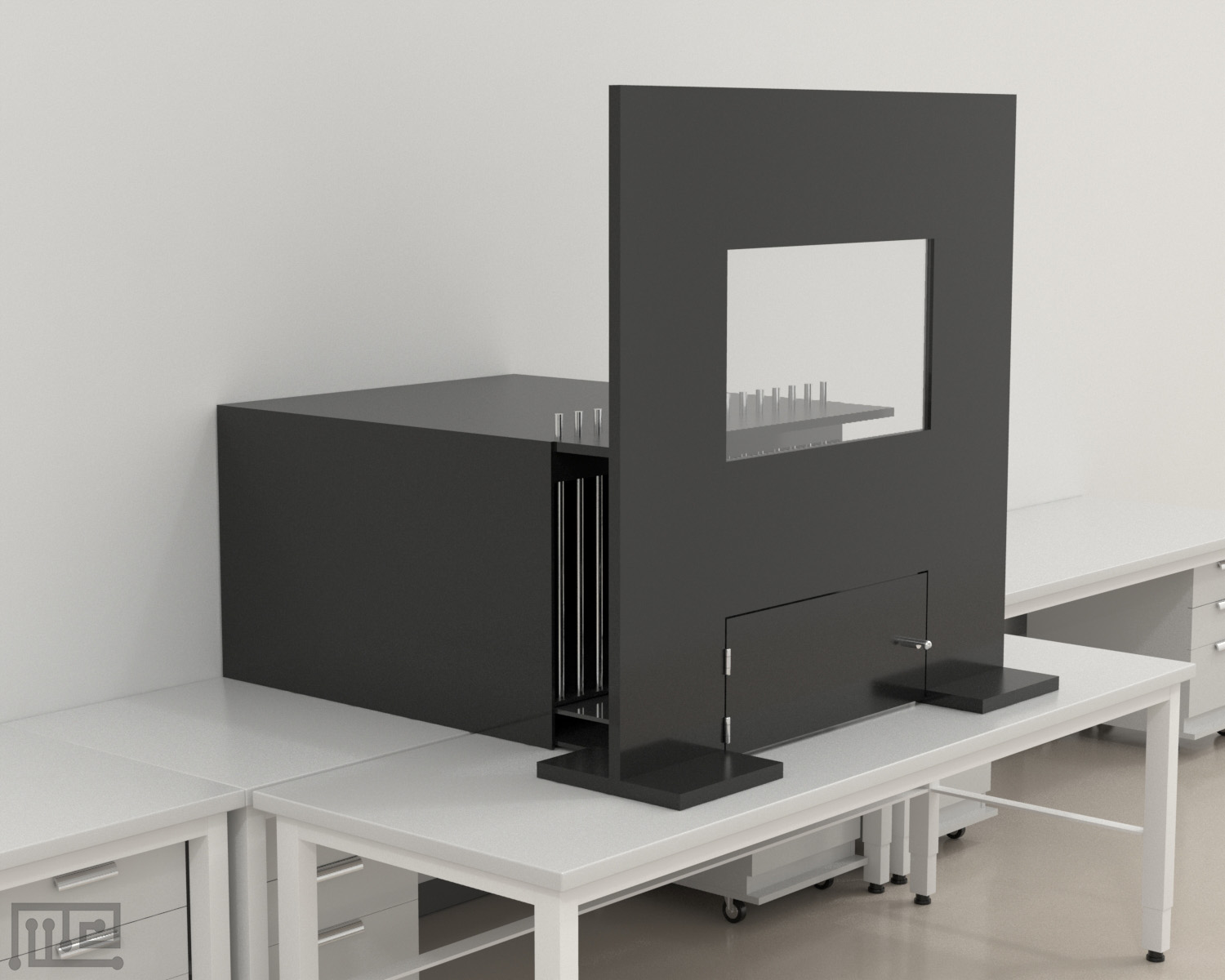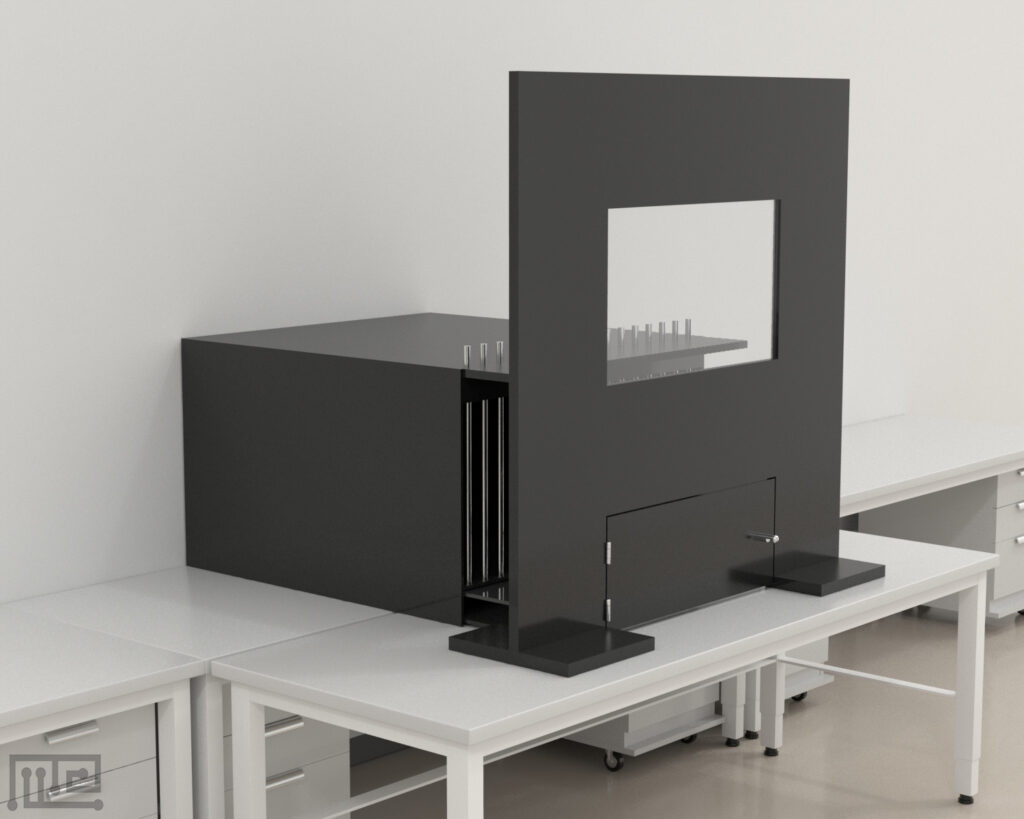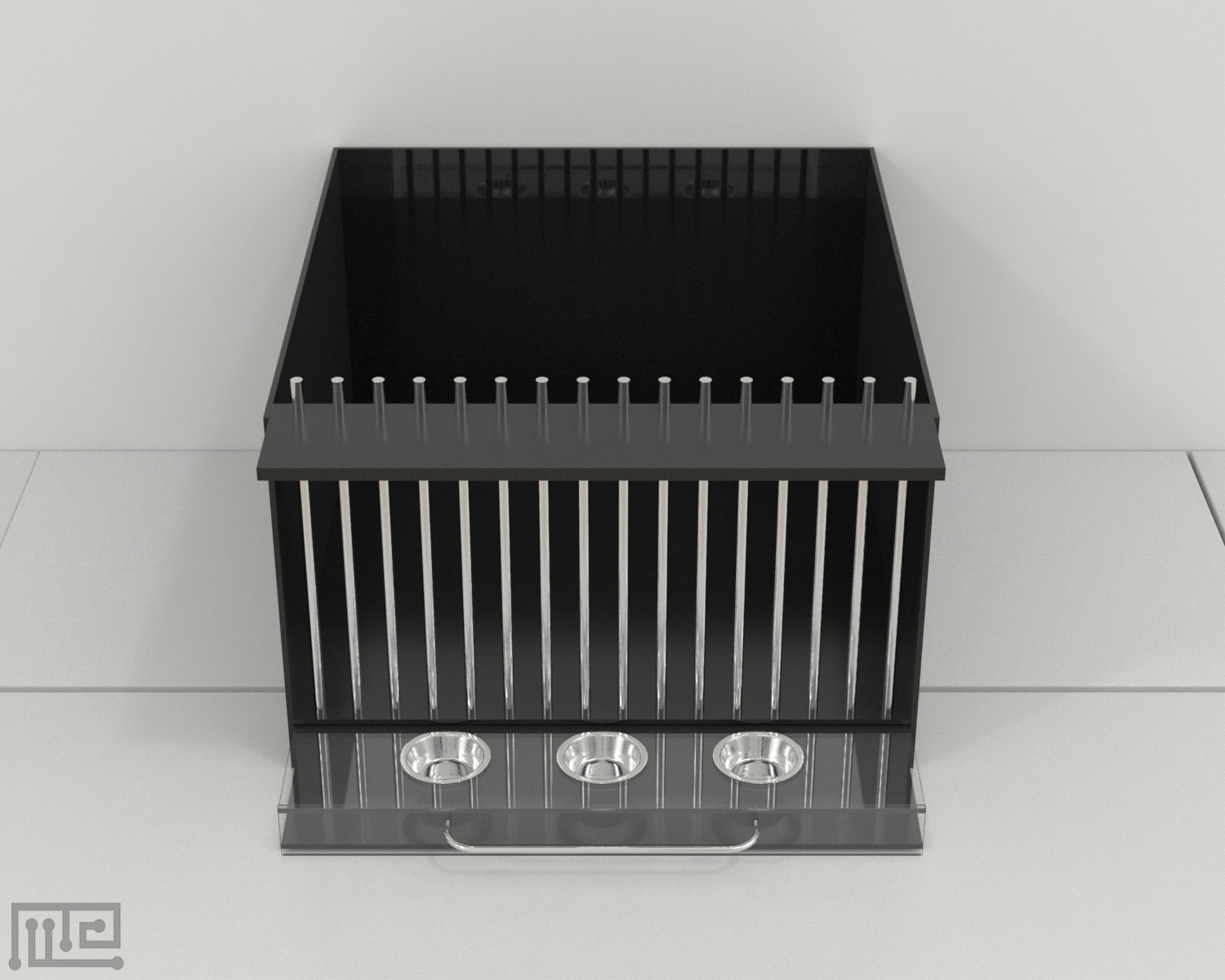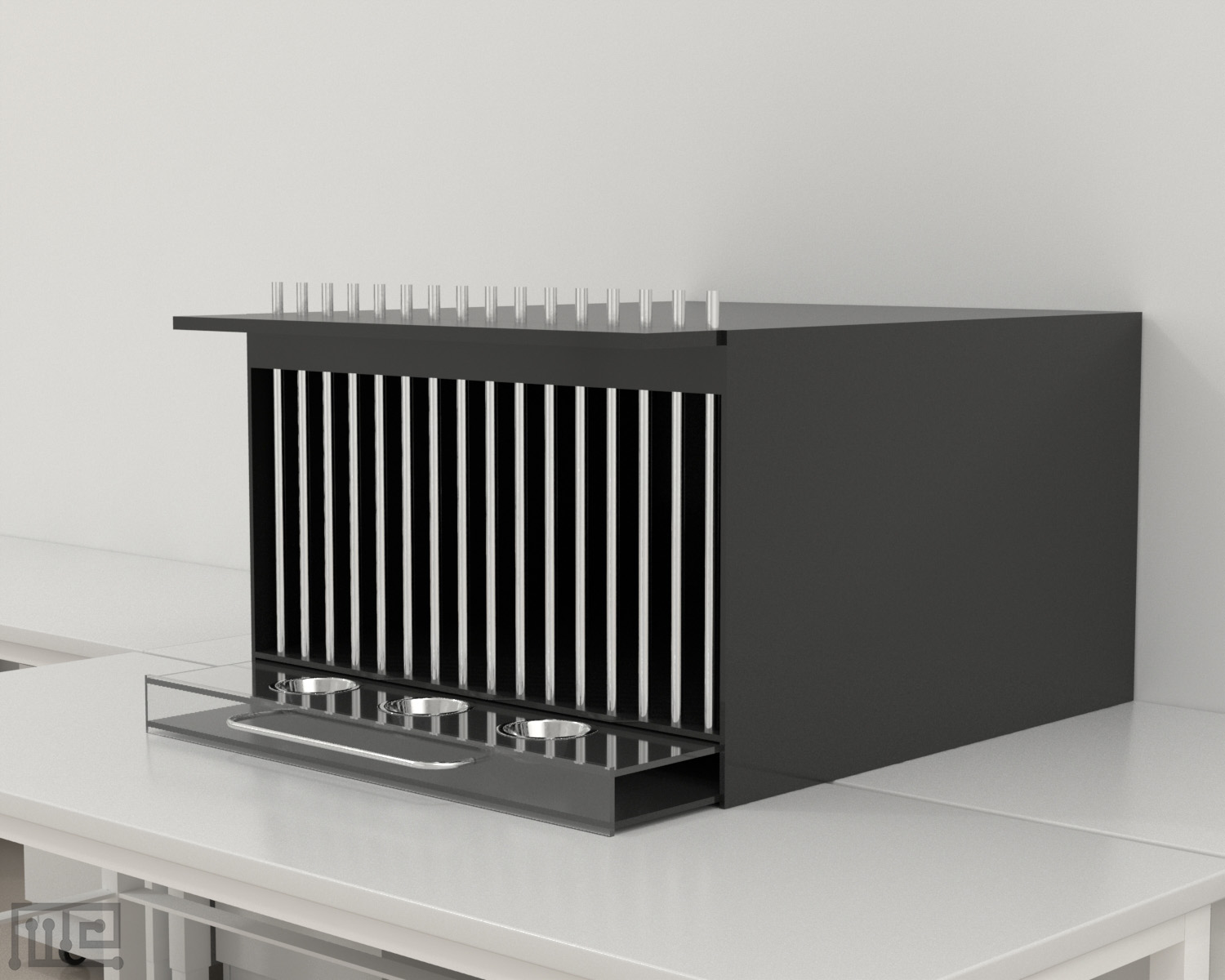The Dog (Canine) DNMS test apparatus was used by Norton W. et al. (1994), to assess cognitive Functions and Aging, Acquisition of Nonspatial Visual Tasks in the Dogs.
The test apparatus was an acrylic box that was based on a canine adaptation of the Wisconsin General Test Apparatus described by Fox (1971).
The box was equipped with a sliding Plexiglas tray with two lateral wells and a medial food well. Vertical stainless steel bars served as the front of the box. The height of each bar was adjustable, which allowed the size of the opening to each food well to be uniquely set for each dog.
Mazeengineers offers the Dog DNMS test apparatus.
Price & Dimensions
Dog DNMS test apparatus
$ 1990
+S&HLength of apparatus: 0.609-mWidth of apparatus: 1.15-m
Height of apparatus: 1.08-m
Documentation
Introduction
The Dog DNMS (delayed non-matching to sample) apparatus is used to study learning and memory processes in dogs. It is a canine adaptation of the Wisconsin General Test apparatus described by Fox (1971) that is widely used to assess cognition of primates. The Dog DNMS apparatus consists of an acrylic chamber that comes equipped with a sliding tray that contains food wells. It has adjustable stainless-steel bars that can be uniquely set to create openings to reach the wells that can accommodate dogs of different sizes. The tray can also be modified to hold different number of wells if required. Food can be smeared in the incorrect wells or be stuck to the bottom of both the positive and negative stimulus in the wells to avoid the subjects from using olfactory cues in solving the task.
The dog serves as a well-suited animal model for aging and neurobiological studies because of similarities in neuropathology between the human brain and the dog brain (Head, 2013). The Dog DNMS apparatus task involves the acquisition of the food reward from one of the food wells. The protocol can be easily applied for tasks that use different visual cues such as object discrimination, size discrimination, and landmark discrimination. A major advantage of using the Dog DNMS apparatus is the ability to apply several cognitive test protocols that assess learning ability, visuospatial function, and attention. Additionally, the apparatus can be applied to assess working memory as well as test egocentric and allocentric strategies in dogs (Pan, Kennedy, Jonsson, & Milgram, 2018). The Dog DNMS apparatus can also be used to evaluate cognitive abilities and age-related changes in the dog as well as test a number of different therapeutics.
Other apparatus used to test learning and choice behaviors in animals includes the Pig DNMS Task, the Novel Object Recognition Test, the Dig Task, the Bat Y-maze, and the Zebrafish Bifurcating T-maze.
Apparatus and Equipment
The Dog DNMS apparatus consists of an acrylic chamber that measures 0.609 m x 1.15 m x 1.08 m to house the animal. The chamber comes equipped with a sliding tray containing two lateral food wells and a middle food well. The front of the box contains adjustable vertical stainless-steel bars to provide openings for the animal to obtain food from the food wells which can be uniquely adjusted for each dog. A screen with a one-way mirror and a hinged door below the mirror visually separates the subject from the experimenter. Lighting is provided through a 60 W bulb attached to the front of the box.
Training protocol
Clean the apparatus thoroughly before starting the trial. Appropriately light the apparatus. A tracking and recording system such as the Noldus Ethovision XT can be used to assist with observations.
Habituation and Pre-training
Conduct pre-training sessions in four phases using only two food wells
Phase 1
Place the food rewards in the two food wells and train the subject to consume the reward through the openings in the bars.
Phase 2 (Reward Approach Learning)
Place the food reward in either the left or right food well with the screen lowered. Raise the screen and present the subject with the tray. Let the subject choose food well and eat the reward. Conduct 10 trials daily, with an inter-trial interval of 90 s with the correct food well randomly selected, ensuring both wells are equally presented in the sessions. Conduct trials until the subject learns to associate food reward with the presentation of the tray and correctly responds on 9 out of 10 trials or on 8 out of 10 trials for 2 successive days. Conduct a single correction trial after the subject makes the first incorrect response.
Phase 3 (Discrimination Learning)
Place the food reward in either the left or right food well and partially cover it with an object. Conduct trials until the subject learns to displace an object to obtain the reward. After the subject consistently finds and eats the visible reward, cover the reward completely on subsequent trials.
Phase 4 (Object Approach Learning)
Randomly select a different stimulus object as the correct object. Place the object over the food reward in either the left or right well. Conduct trials in the same manner as phase 3 however, only use one object. Conduct trials until the subject learns to displace the single object in order to obtain a reward after the presentation of the tray. Conduct 10 trials daily, with an inter-trial interval of 90 s. Conduct trials until correctly responds on 9 out of 10 trials or on 8 out of 10 trials for 2 successive days.
Object Discrimination Task
Smear food in the two food wells to avoid odor cues. Stick a small piece of food to the bottom of both the negative and positive stimulus objects. Randomly select the position of the correct stimulus, ensuring that on 5 out of 10 trials, the correct stimulus is on the right lateral food well. Open the hinged door and present the tray with the two objects to the subject. Allow the subject to displace one of the objects and eat the food if it displaces the correct object. Withdraw the tray and close the hinged door. Conduct 10 successive trials per day with an inter-trial interval of 90 s. Conduct trials until the subject reaches the learning criteria.
Reversal task
After the object discrimination trials, present the subject with the same two stimuli, however, associate the reward with the previously non-rewarded stimulus. Conduct trials in the same manner as the object discrimination task until the subject reaches the learning criteria.
DNMS Acquisition task
Begin DNMS acquisition trials following the reversal trials. Perform a sample trial with the reward placed in the middle food well. Cover the reward with a single object (the sample) and allow the subject to displace the object and eat the reward. After a 10 seconds delay, present the subject with two objects covering the left and right wells. Place the sample object over an empty well and a novel object over the rewarded well. Change the objects after every trial always associating the novel object with the rewarded well. Randomly change the position of the novel object, ensuring that each object is equally presented in both wells across trials. Conduct 10 successive trials per day with an inter-trial interval of 90 s. Conduct trials until the subject reaches the learning criteria. If the subject does not reach the learning criteria, reduce the delay to 5 seconds. Allow the subject a maximum of 20 additional trials to achieve criterion at the shorter delay.
Variable delay task
After conducting the acquisition trials, select the subjects that reached the criterion in the 10 seconds delay test. Perform the variable delay trials in the same manner as the acquisition trials; however, randomly fix the delay between 10 and 50 seconds across trials. Conduct trials until the subject reaches the learning criteria.
Evaluation of cognitive enhancements in dogs from dietary supplementation with a nutrient blend
Pan, Kennedy, Jonsson, and Milgram (2018) evaluated cognitive enhancement in old Beagle dogs from dietary supplementation containing arginine, antioxidants, B vitamins, and fish oil. Twenty-four Beagle dogs (9.5-11 years old) of both sexes were divided into control and treatment groups and tested on the Dog DNMS apparatus. The dogs performed a series of cognitive test protocols, which assessed landmark discrimination learning, egocentric discrimination learning, and reversal learning. The landmark discrimination task utilized external landmarks to locate the rewarded well, while the egocentric task focused on the ability of the subject to respond to an object based on its proximity. Results indicated that the groups did not differ significantly on the first phase of the landmark discrimination task and on the initial egocentric discrimination task. However, the supplemented group showed significantly better performance than the controls on the second component of the landmark discrimination task, and on reversal learning of the egocentric discrimination task.
Investigation of independence of working memory from object learning, selective attention, and motor learning
Zanghi, Araujo, and Milgram (2015) investigated learning and attention performance as differing cognitive domains in 60 beagle dogs (9-16 years of age) using the Dog DNMS apparatus. The dogs were classified into three groups: low performing, moderate performing, or high performing spatial working memory. The dogs were then trained over 30 days on the variable object oddity task, which consisted of three phases: acquisition phase, same distractor phase, and different distractor phase. In the acquisition phase, the dogs were required to select the odd object out of 2, 3, or 4 total objects where the other objects were all the same size and color. In the same distractor phase, the object that was rewarded during the acquisition phase was always rewarded in this phase, while for the different distractor phase, the positive stimulus still remained unchanged. However, the negative stimulus closely resembled the rewarded object. Results from the acquisition phase revealed that the dogs over 12 years of age performed more poorly compared to the 9–12-year-old dogs. The low performing group performed more poorly than the other two groups, while the moderate performing group had the best performance out of the three. The same distractor and different distractor tests revealed no significant differences between age and task in both tests. However, when analysis without considering age groups was performed, significant effects were seen between task and number of distractors, but no significant differences were observed between cognitive groups. A final motor learning task was performed to assess the motor skills of subjects using a motor learning or re-learning protocol. The task was performed using a chamber with an opening from which the subjects could only extend their paw to obtain the food reward, and the distance to the reward was increased incrementally. The task was independent of visuospatial memory and complex discrimination learning. It was observed that working memory performance did not predict the success of psychomotor learning, and maximum motor learning distance did not differ between the groups.
Evaluation of Cholinesterase inhibitors on memory and learning in aged dogs
Araujo et al. (2011) evaluated the effect of cholinesterase inhibitors phenserine and donepezil on the performance on the acquisition task and oddity discrimination task. In the phenserine study, five male and two female beagle dogs were divided into phenserine and control groups. The dogs were tested on relearning and variable-delay paradigms, and the delays were set to 20 and 80 s. Higher performance levels were found in the phenserine treated subjects compared to the control group, and lower performance levels were found at the 80 s delay compared to the 20 s delay. The dogs were also tested under scopolamine and saline vehicle. Results at the 20 s delay indicated that scopolamine significantly reduced performance in the control group compared to both stabilization and saline; however, no differences were seen in the phenserine group. At the 80 s delay, scopolamine significantly impaired performance in the phenserine group while the performance of the control group did not differ significantly. Results from the oddity task revealed that more errors were committed on the second oddity problem under the placebo condition compared to phenserine, while during the first oddity problem no difference between phenserine and placebo treatment was found. For the donepezil study, 46 aged beagle dogs were tested under a variable-delay paradigm using 20 and 90 s delays. The effect of donepezil showed similar results to phenserine and had improved performance at the longest delay of 90 s compared to baseline and wash-out.
Evaluation of spatial ability in aged dogs following dietary and environment enrichment
Nippak, Mendelson, Muggenburg, and Milgram (2007) evaluated cognitive development in young and aged beagle dogs over a three-year period using the Dog DNMS apparatus. The study was aimed to assess age-dependent decline in learning ability and to assess the effectiveness of behavioral enrichment and dietary supplementation with a broad spectrum of antioxidants and mitochondrial cofactors. The subjects were divided into two groups. The first group consisted of 48 aged dogs of both sexes ranging from 8-12 years and were divided into four cognitively equivalent groups with two treatment conditions (dietary fortification and behavioral enrichment). The second group consisted of 16 young dogs that were divided into two cognitively equivalent groups of control food and enriched food with both groups receiving enrichment experience. Enriched animals were tested on size discrimination tasks and reversal learning tasks where they had to displace identical objects of different sizes. Half of the enriched animals were tested on the 3-DNMP task (Delayed non-matching to position) which involved three sample/non-match subtest configurations based on the location of the sample, and then were tested on an object discrimination learning task, while the other half were tested in the reverse order. Landmark discrimination and oddity discrimination task were also performed. Results indicated that a dietary intervention fortified with antioxidants and mitochondrial cofactors improved 3-DNMP performance in aged dogs. In contrast, the young dogs maintained on the antioxidant-rich diet did not display performance improvements. Dietary supplementation and enrichment also enhanced aged dogs’ performance across the discrimination and reversal tasks. Overall, dietary supplementation and behavioral enrichment enabled aged animals to adopt better strategies for solving the 3-DNMP task and enrichment facilitated the adoption of a cognitive strategy in some aged animals.
Evaluation of age-dependent cognitive decline in the dog using a delayed non-matching to position task
Adams et al. (2000) evaluated spatial learning, spatial memory, and maximum spatial learning capacity in the dog using a delayed non-matching to position task in young and old dogs. Young (1–3 years old) and old (8–12 years old) mixed breed and beagle dogs were used in the study. Results from the acquisition task revealed that 9 out of 50 old dogs failed to reach criterion at the 10 seconds delay interval. However, all young dogs were able to successfully acquire the task within 400 trials at delays of 10, 20, and 30 s. A subset of five old dogs was tested for an additional 70 training sessions to investigate whether variable delay task performance in the old group could improve as a function of extensive training. It was observed that performance improved with extended practice in old dogs. Although task performance improved with practice, the rate of learning was significantly faster in young dogs compared to old dogs. Comparison of performance on the acquisition task and variable delay task revealed performance was related in young, but not old dogs. Results from the progressive delay task revealed that the maximum spatial working memory capacity of young dogs was significantly greater than the maximum spatial working memory capacity of old dogs. Overall, aged dogs showed impaired spatial learning, displayed spatial working memory deficits, and showed a reduced maximum spatial memory capacity compared to young dogs.
Evaluation of cognitive functions and aging in the dog
Milgram, Head, Weiner, and Thomas (1994) evaluated age-dependent cognitive changes in beagle dog on the learning of non-spatial visual tasks. Twenty-five dogs were separated into young beagles (1.5-2 years), middle-aged beagles (5-10 years), and old mixed breed groups. The dogs were tested using object discrimination learning, reversal learning, and acquisition paradigms on the Dog DNMS apparatus. It was observed that learning was inversely related to age for all three tasks. On the reversal learning test and DNMS acquisition, both the young and mature group learned the task faster than the old group. On the discrimination learning task and reversal learning task, the mixed-breed animals made more errors than the beagles. However, there were no differences in the learning of the DNMS task. The variable delay task increased the task difficulty, and the best of the dogs made errors on more than one-third of the trial. The variable delay task was also performed to distinguish young and middle-aged dogs. All of the young animals performed significantly greater than chance while only one of the middle-aged dogs performed significantly greater than chance.
Data Analysis
The following can be observed using the Dog DNMS apparatus:
- Number of times the subject chooses the correct well
- Number of times the subject chooses the incorrect well
- Number of times the subject chooses the right well
- Number of times the subject chooses the left well
- Number of times the subject chooses the middle well
- Time taken for the subject to complete a trial
- Number of errors made
Strengths and Limitations
Strengths
The Dog DNMS apparatus allows investigation of cognitive abilities in dogs. It consists of a chamber that is equipped with a sliding tray that can be modified to hold different number of food wells. Adjustable stainless-steel bars are present to create openings that can be uniquely set for each subject to reach the food wells. The protocol can be easily applied for tasks that use different visual cues such as object discrimination, size discrimination, landmark discrimination, and oddity discrimination. Apart from testing cognitive functions, the Dog DNMS apparatus can also be used to evaluate the effects of diseases and disorders, brain lesions, and pharmacological manipulations on learning and memory behaviors.
Limitations
Training of the subjects is important for task performance. Each task requires a large number of trials to be conducted to get accurate results. Pre-training sessions tend to take a substantial amount of time to be conducted. Factors such as age, gender, and strain of subjects may influence task performance. Unintentional stimuli may affect the way the subject performs the task.
Summary
- The Dog DNMS apparatus is used to study learning and memory processes in dogs.
- It consists of an acrylic box chamber that comes equipped with a sliding tray and adjustable stainless-steel bars that are used to create openings that can be uniquely set for each subject.
- The sliding tray holds food wells, which can be adapted to hold a different number of wells according to different investigatory needs.
- The Dog DNMS apparatus can also be used to assess age-related cognitive abilities in the dog.
- A major advantage of using the Dog DNMS apparatus is the ability to apply several cognitive test protocols that assess learning ability, visuospatial function, memory, and attention.
References
- Adams, B., Chan, A., Callahan, H., Siwak, C., Tapp, D., Ikeda-Douglas, C., … & Milgram, N. W. (2000). Use of a delayed non-matching to position task to model age-dependent cognitive decline in the dog. Behavioral brain research, 108(1), 47-56.
- Alberts, A. W. (1990). Lovastatin and simvastatin-inhibitors of HMG CoA reductase and cholesterol biosynthesis.Cardiology, 77(Suppl. 4), 14-21.
- Araujo, J. A., Greig, N. H., Ingram, D. K., Sandin, J., de Rivera, C., & Milgram, N. W. (2011). Cholinesterase inhibitors improve both memory and complex learning in aged beagle dogs. Journal of Alzheimer’s Disease, 26(1), 143-155.
- Head, E. (2013). A canine model of human aging and Alzheimer’s disease. Biochimica et Biophysica Acta (BBA)-Molecular Basis of Disease, 1832(9), 1384-1389.
- Fox, M. W. (1971). Integrative development of brain and behavior in the dog. Chicago: University of Chicago Press.
- Milgram, N. W., Head, E., Muggenburg, B., Holowachuk, D., Murphey, H., Estrada, J., … & Cotman, C. W. (2002). Landmark discrimination learning in the dog: effects of age, an antioxidant fortified food, and cognitive strategy. Neuroscience & Biobehavioral Reviews, 26(6), 679-695.
- Milgram, N. W., Head, E., Weiner, E., & Thomas, E. (1994). Cognitive functions and aging in the dog: acquisition of nonspatial visual tasks. Behavioral neuroscience, 108(1), 57.
- Nippak, P. M. D., Mendelson, J., Muggenburg, B., & Milgram, N. W. (2007). Enhanced spatial ability in aged dogs following dietary and behavioural enrichment. Neurobiology of learning and memory, 87(4), 610-623.
- Pan, Y., Kennedy, A. D., Jönsson, T. J., & Milgram, N. W. 2018). Cognitive enhancement in old dogs from dietary supplementation with a nutrient blend containing arginine, antioxidants, B vitamins and fish oil.British Journal of Nutrition, 119(3), 349-358
- Zanghi, B. M., Araujo, J., & Milgram, N. W. (2015). Cognitive domains in the dog: independence of working memory from object learning, selective attention, and motor learning. Animal cognition, 18(3), 789-800.
Request a quote
"*" indicates required fields




